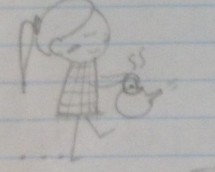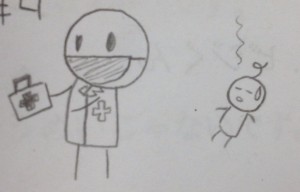 Okay, yes – I give homework. But I’m happy to say that my view of what constitutes homework is evolving. As much as possible I am trying to inject some choice into ‘what’ students express. Lately I have also been experimenting with the ‘how’ they choose to express themselves. I want to be quick and say that I am not an artist but I do know the value of a visual – even a basic one. I often use a quick picture: the one to the left is to help students studying the variety of uses for verbs of giving and receiving in Japanese.
Okay, yes – I give homework. But I’m happy to say that my view of what constitutes homework is evolving. As much as possible I am trying to inject some choice into ‘what’ students express. Lately I have also been experimenting with the ‘how’ they choose to express themselves. I want to be quick and say that I am not an artist but I do know the value of a visual – even a basic one. I often use a quick picture: the one to the left is to help students studying the variety of uses for verbs of giving and receiving in Japanese.
Now I have been asking my students to do something similar to demonstrate their learning. For practice I ask them to come up with 5-6 examples of the concept in use – and to draw a quick sketch to match each of their examples. This is the ‘out of class’ portion of the work. There isn’t a student in my class who can’t come up with a drawing – and a ‘stickman’ is the standard.
The next day is the ‘interactive’ portion – and the one that I find brings the most value. Prior to working with others, students have the chance to check out their work with their partner. They show them their sketch and see if their partner can come up with what the caption would be. This also allows them to check that the concepts illustrated, and in their caption, are used correctly.
 Then it’s on to the ‘interacting’. I ask them to meet and challenge 4 classmates to come up with the captions to their pictures. They can meet with any 4 people in the room, the only stipulation is that all of their interacting/reacting is in the target language. If the person guessing doesn’t do so correctly they use culturally appropriate gestures/phrases to indicate that they aren’t correct.
Then it’s on to the ‘interacting’. I ask them to meet and challenge 4 classmates to come up with the captions to their pictures. They can meet with any 4 people in the room, the only stipulation is that all of their interacting/reacting is in the target language. If the person guessing doesn’t do so correctly they use culturally appropriate gestures/phrases to indicate that they aren’t correct.
 Suddenly the room is alive with noise and students are unaware that they are practicing 20-24 times. They enjoy seeing everyone’s visuals and the element of ‘guessing’ ups the energy.
Suddenly the room is alive with noise and students are unaware that they are practicing 20-24 times. They enjoy seeing everyone’s visuals and the element of ‘guessing’ ups the energy.
The ‘sketch and share’ option really gets students helping each other to show their learning – and any opportunity for them to do this works for me!
Colleen


3 Comments
Leave a reply →